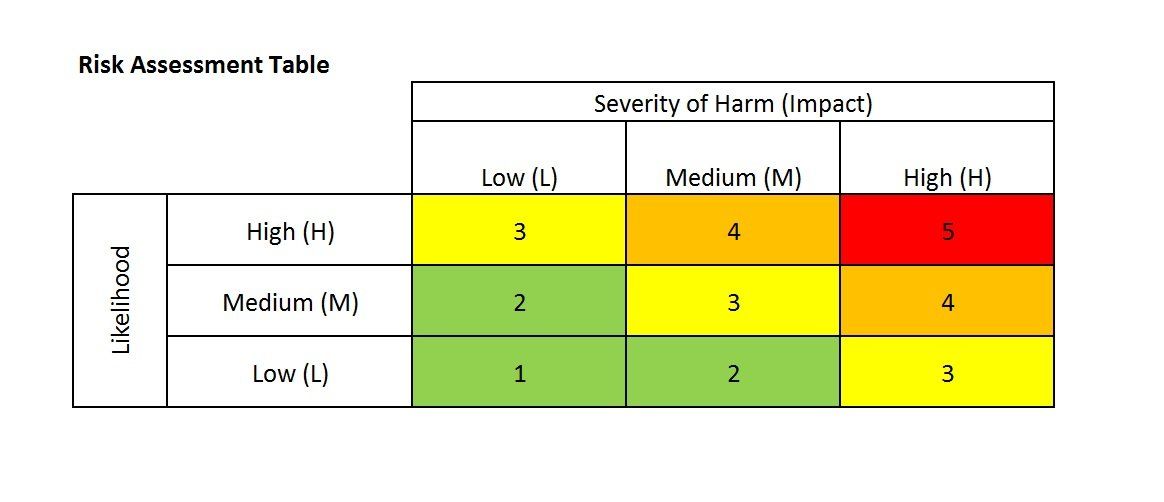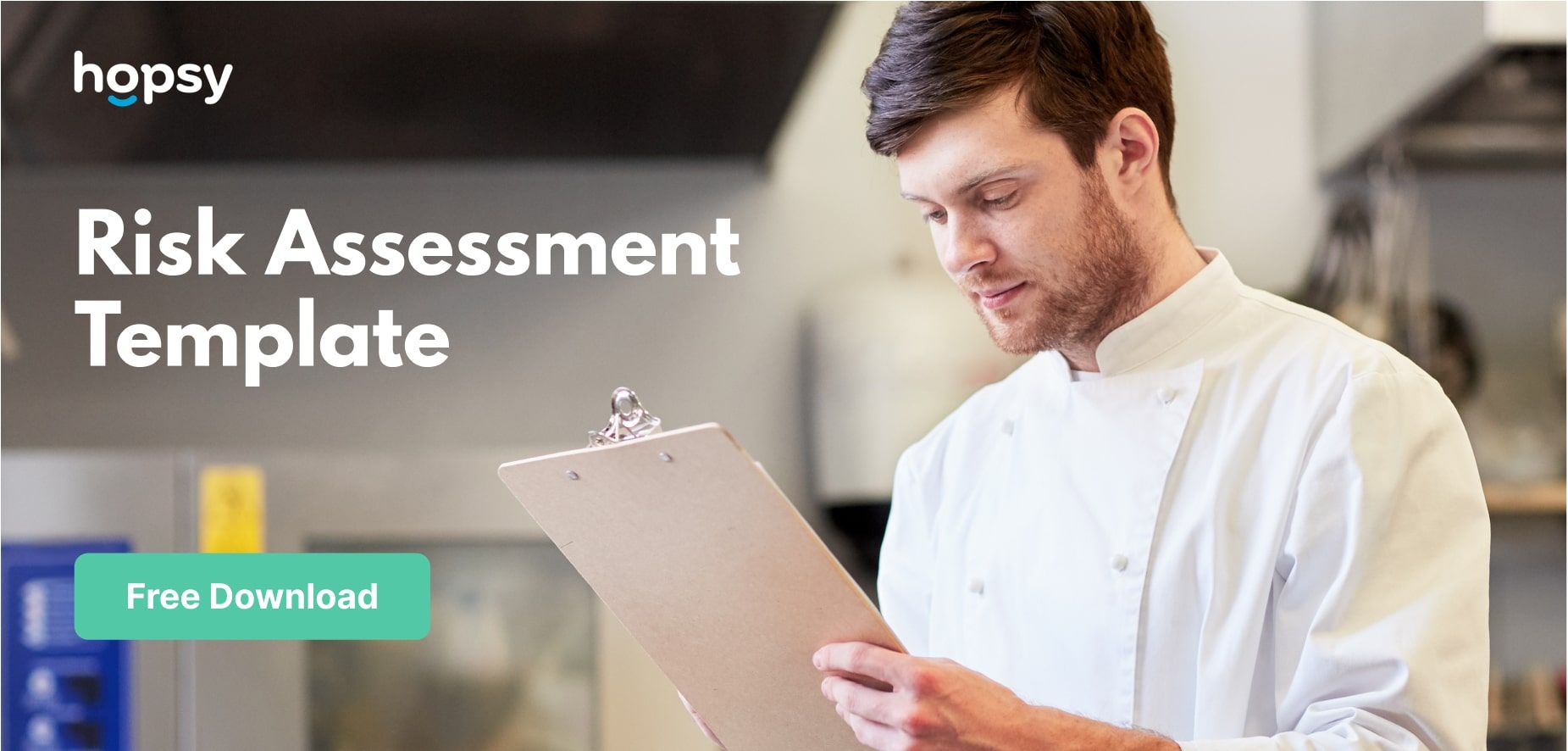Article
Risk assessment template: guide with examples

Risk assessment template: the right structure for your business
There are plenty of risk assessment templates available and how they are implemented can vary from business to business. However, they all serve the same purpose, following a very similar structure:
Free risk assessment at the end of the article
Risk Assessment template in 5 steps

- Identify hazards in the workplace
- Who might be harmed
- Risk Mitigation
- Communicating the risk assessment
- Review
Learn more about what goes into these steps and where to start with risk assessments by reading our blog on the topic; 5 steps to a risk assessment
Using a risk assessment template and following this structure ensures you are covering all bases to effectively manage risk in a format that clearly shows your commitment to workplace safety. Your risk assessments should cover various areas of the business from food safety to proper equipment handling. Doing this ensures you are covered on all fronts which is an important part in maintaining a safe work environment and ensuring you are complying with industry standards.
Standard practice for presenting your risk assessments has always been paper forms or excel documents, which have always been a bit of a pain to use. Alternatively, you can use risk management tools which provide you with a simple template that adapts to your needs, making the management process smooth from beginning to end. Learn more about how our solution to the risk assessment process or try it for free today
How to do a risk assessment?
For a well structured risk assessment it's important you break it down into 5 stages covering these areas in the report;
1. Identify the hazards
Clearly explain what the risk assessment is for, e.g. cleaning fryers. Make sure you give it a clear title and description. You will then need to identify all of the possible hazards that contribute to the risk.

Some of this will be common sense but it's important to assess all possible hazards objectively to minimise risk to your staff and stay covered if something were to go wrong. Even if you think the risk it poses is quite low or negligible.

2.Who could be harmed and how?
Identifying who is at risk and how is the most important part of the risk management process. Who is at risk from the hazards you identified?

By outlining who is at risk you can more effectively implement control measures to minimise the risk they pose to these people. Try to be specific to roles or responsibilities as different people will be at different levels of risk.
It's good industry practice to implement risk ranking based on severity of harm and the likelihood of it happening.
Consider;
- What control measures you have in place already
- The severity of harm if an accident is to occur
- How much of a risk it poses to the individual
- The likelihood of it happening

Assess all of these factors when doing risk rankings. This will help prioritise your time when adding control measures and ensure high risk areas are given more attention.
**Low risk - rating 1- 2 **
It doesn't pose much risk but there still may be things you can do to bring the rating down even more.
**Medium risk - rating 3 **
Requires your attention. Review existing safety measures and add any additional controls to bring the rating down to low risk.
High risk - rating 4
Immediate action needs to be taken. Under no circumstances should you continue operation if it poses a high risk. Examine the hazards, how work is taken out and what control measure you can add to bring it down to a low rating. If you still think something poses a high risk you must speak to a professional advisor or cease operation of high risk activity.
3. How are risks managed?

Your risk management plan should clearly identify the control measures you have put in place to mitigate the risk. Just imagine a worst case scenario where all of the hazards you identified happen; how do you make sure it doesn't happen again? What measures can you take to ensure the risk is managed?
Looking through past incident reports (if you have any) can be a good starting point if you need something to get the ideas flowing. Alternatively you can question your staff especially when it comes to kitchen safety. Chefs and line cooks will often have experience around dangerous machinery or equipment and fully understanding their role can give you a better idea of where the danger lies and how to minimise it. Looking at equipment manuals can achieve a similar result.
4. Communicating your risk assessment

Knowing what the risks are and how to avoid them is only half the battle, it's then up to you to make sure your mitigation plan is implemented and followed. This is where clear communication is needed, all relevant members of staff need to have read and signed off the plan to show it has been understood and is being followed.
5.Risk assessment review
How do you make sure it's being followed?
That's not always an easy question to answer. Once you have implemented your risk assessment it's important that it is effectively communicated, and your teams are trained to work as risk free as possible. Effective communication and training can help to create a more safety conscious culture.
This process can be simplified with risk management software which keeps you updated on every stage of the risk management process. Learn more about our solution to risk assessments
Following this, It's especially important to keep an eye on the areas of highest risk to make sure everyone is following safe procedures at all times. Completing regular checks will quickly make following your risk management plan second nature to staff and create a safer work environment for everyone.
However, things can change as time goes on. Staff fall out of practise, attention shifts elsewhere and standards can drop overtime. That's why it's important to complete annual reviews to upkeep standards and factor in changes to your business which are not covered in your risk assessment.
Are control measures being followed? Have circumstances around hazards changed? Have any new risks been introduced?
These are all questions you must consider because it's crucial that your risk assessments are up to date. Year old documents will not be sufficient evidence if an accident is to occur so it's important that you upkeep your commitment to workplace safety. It can be the thing that stops someone from seriously getting hurt.
It is also highly recommended that risk assessments are reviewed again should an accident occur. It’s important to look at if the accident could have been avoided had extra control measures been in place. If so, these extra measures should be implemented alongside existing mitigations.
All of this can be a very hands on process and cost you a lot of time especially if you run a busy venue or even multiple. Luckily it can be done in just a few clicks using our free risk assessment template(There's even a few prebuilt ones in there for you to use already!)
Learn more about our risk assessment process or try it for free today!

